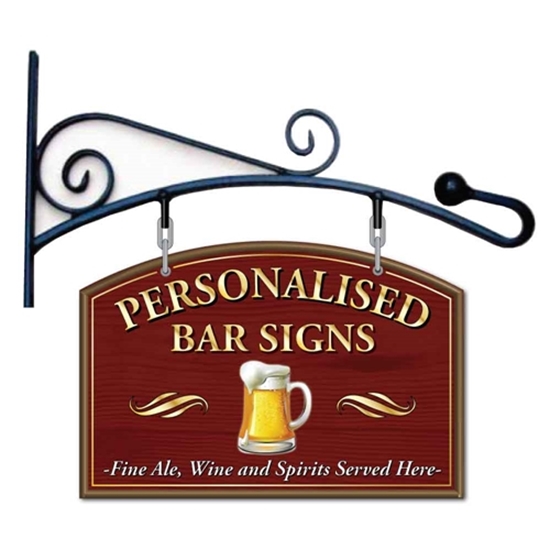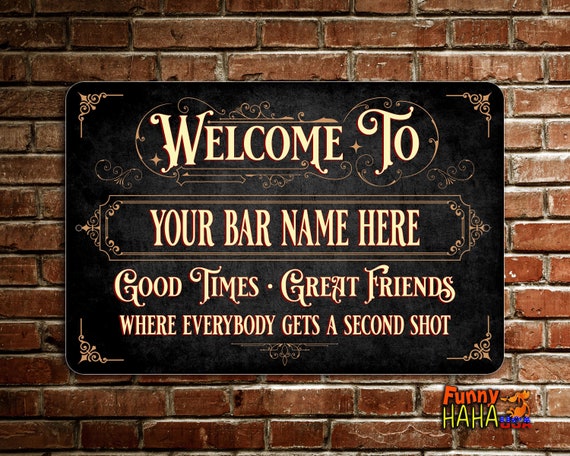New Advice On Deciding On Bar Signs
Wiki Article
What's The Difference In Bar Sign Sizes?
There are various sizes for bar signs based on the function of their design, their location, and how they look. Here's a look at how the size of bar signs affects their aesthetics and functionality: 1. The Big Sign
The function of an Arrow is to draw the attention of others and serve as a focal point.
Examples include: outdoor signage, branding and walls with a focal point.
It is often placed over entrances, outside bars or on large wall surfaces to draw customers.
Examples: huge neon signs or oversized vintage style signs, or expansive wall-mounted signs.
2. Medium Signs
The goal is to add information or improve the design without taking up excessive space.
The uses include menu boards, advertising displays and directional signs.
Placement: Positioned so that it is easily visible but not overwhelming.
For instance chalkboards of medium size with daily specials, or metal signs featuring the bar logo.
3. Small Signs
To embellish your home with subtle details and/or specific aspects.
Applications: Small, decorative pieces or labels.
Tables and displays should be placed in a way which are near to the viewer.
Examples include Table number signs, or even small frame quotes.
Size Factors
Visibility
Large Signs: Made to be seen from a distance, which makes the perfect choice for attracting people as well as establishing the bar's presence.
Medium Signs: These signs are ideal for balancing visibility with space efficiency and providing important information, without imposing décor.
Small Signs - Ideal for details and information that are close-up. They are able to be positioned at eye or table level to increase the enjoyment of patrons.
Proportion
Large Signs: They must be proportionally large in order to prevent overwhelming smaller areas. Most suitable for large or open spaces.
Medium Signs: Perfect for most spaces, and can be placed in a variety of ways.
Smaller signs: Ideal to add details and to fit into smaller spaces with less clutter.
Impact
Large-sized signs: They can make a bold statement, and they can also serve as branding elements. They are frequently employed to establish the tone at the bar.
Medium Signs Creates an equilibrium between decor and visibility and contributes to the overall atmosphere while conveying important information.
Small Signs: Provides beauty and details, which contributes to a multi-layered and rich visual experience.
Practicality
Large Signs (Large) These signs require substantial mounting options, and are usually more costly due to their size.
Medium Signs are easier to set up and move. They also provide flexibility with regard to design modifications.
Small Signs: Simple to replace and update These signs are great for environments that are dynamic, like bars, where the menus or promotions alter frequently.
Functionality
Large Signs are typically functional and attractive.
Medium Signs are both decorative and functional. They provide essential information while also adding the aesthetics.
Small Signs are mostly functional and offer details. They also add to a theme or decor.
The dimension of bar signs will be determined by their function as well as the design and their impact on patrons. This ensures that the signs' contribution to the bar atmosphere and operational needs. Read the top make a pub sign examples for website examples including personalised home bar signs, personalised hanging bar sign, the pub sign, hanging tavern sign, pub signs made, large bar signs, the staying inn bar sign, indoor bar signs, home bar pub signs, bar sign outdoor and more.

What Is The Difference Between Bar Signs And Other Types Of Signage In Terms Of Light?
Bar signs are different in terms of lighting. This can affect the appearance, atmosphere, and impact. Here are some key ways in which the lighting of bar signs could be affected: Neon Signs
Characteristics: Bright, colorful, classic.
Lighting: Uses neon gas-filled tubes that emit light when charged.
Uses for this product It's ideal to give an old-fashioned retro vibe.
Benefits: It is highly visible from an extended distance. It also has a nostalgic feel.
Negatives: They can be brittle and costly to repair.
2. LED Signs
Characteristics: Energy-efficient, versatile, modern.
Lighting: LEDs produce bright, vibrant light.
Uses : Indoor and outdoor signs can be used and an adjustable display and dynamic lighting effects.
Benefits: The LEDs last a long time, are energy efficient, and they are programmable with animated or color changes.
Advantages: May be costly initially, but can save on energy and maintenance costs.
3. Signs with Backlights
Characteristics: Elegant, sophisticated, subtle.
Lighting: Puts light sources such as fluorescent bulbs or LEDs, on a translucent surface to create a soft glow.
Uses: Used for modern bar signs, menu boards and branding elements, for example.
Advantages: Provides a sleek and professional look, enhances visibility in dim lighting.
The installation process is more complicated and the initial cost is higher.
4. Signs that Edge-Lit
Characteristics: Sleek, contemporary, stylish.
Lighting: Lights up the edges of a sign panel usually acrylic, using LEDs.
Uses: Perfect for modern, minimalist designs. Used for directional or informational signage.
Benefits: Energy efficient, it gives a distinctive and sophisticated appearance.
Disadvantages : Limited to specific designs styles.
5. Ambient/Accent Lighting
Characteristics: Subtle, atmospheric, decorative.
Lighting: Make use of indirect light sources to enhance and highlight signage.
Uses Increases the mood. Most often, it is used to showcase artwork or theme décor.
Advantages: Provides an atmosphere and depth to create a warm and welcoming space.
Negatives
6. Marquee Signs
Characteristics: Bold, theatrical, eye-catching.
Lighting: Multiple light bulbs or LEDs are used around the edges of the sign.
Signs used for exterior use include events, creating vintage film appearances, and event promotional.
Benefits: Increased visibility and attention-grabbing.
Disadvantages : Costly and require regular maintenance.
7. Projection Signs
Characteristics: Dynamic, innovative, versatile.
Lighting Projectors: A device used to project light and image on a surface or wall.
Uses : Ideal for temporary promotions, special occasions, and displays that are dynamic.
Advantages: No requirement to construct a physical sign structure.
Disadvantages
8. Fluorescent Signs
Characteristics: Bright, cost-effective, traditional.
Lighting: Utilizes fluorescent tube to give light.
Uses : Usually employed on large outside and indoor signs.
Large signs are bright and attractive and are relatively affordable.
Advantages
Tips for Lighting
Visibility
Neon and LED Signs Ideal for attracting attention from a distance, especially in low lighting.
Edge-lit and backlit signs improve readability and give a a polished appearance.
Energy Efficiency
LED signs are highly energy-efficient, and last for a long duration.
Fluorescent and Neon Signs: Less energy-efficient, with neon being more fragile.
Aesthetic Appeal
Neon signs and marquees are ideal for retro and vintage aesthetics.
Signs with backlights and edges that are lit ideal for contemporary, modern designs.
Ambient Lighting: Provides an inviting and relaxing atmosphere.
Maintenance
LED Signs are durable and low maintenance.
Neon signs and fluorescent signs: They require more frequent upkeep and possible repairs.
Cost
LED Backlit Signs - Higher initial costs but lower ongoing expenses
Fluorescent signs are less expensive initially, but they use more energy in the long term.
Flexibility
Projection and Programmable Signs: Flexible display options for moving display and content.
Traditional Signs: More rigid but usually provide a desired look.
The appropriate lighting is able to create the desired atmosphere and to effectively communicate with the patrons. Have a look at the top rated such a good point on man cave signs for more recommendations including large personalised bar signs, bar signs for garden, bar signs, home bar pub signs, personalised hanging bar sign, personalised garden pub sign, buy bar signs, garden bar signs, personalised garden pub sign, hanging bar sign and more.

What Is The Difference Between Bar Signs That Are Interactive And Other Bar Signs?
There are different kinds of interactivity that can be used on bar signs to enhance customer interaction and experience. Bar signs are classified based on the degree of interaction. Static signs
Static signs are an old-fashioned method of distributing information. They don't have any interactive components.
Common Types: printed posters or painted murals as well as traditional neon signs.
2. Digital Displays
Digital Signs can be used to display multi-media content and live-time animations.
Interactivity: Touchscreens can include interactive menus, games or other promotional content.
Benefits: Attract interest, provide dynamic information, and encourage customers to be more engaged.
3. QR Codes
Interactive Links QR codes that are displayed on signs can open menus as well as social media profiles and promotions.
Benefits : Make it easy to access further information, promotional offers or loyalty programs.
4. LED Screens
Dynamic Messaging: LED screens are able to show scrolling text, animations or video content.
Touch-enabled LCD screens allow users to interact with the content. For instance, they can select menu items or play games.
Benefits include: Getting attention through creating experiences that are immersive.
5. Projection Mapping
Immersive Experiences Projection mapping transforms the surface into dynamic displays that provide interactive storytelling and interactive visuals.
Interactivity - Guests are able to engage with projected elements, such as interactive games or virtual experiences.
Benefits: Provide memorable experiences, enhance the ambience, and promote social interaction.
6. Augmented Reality
Enhanced Reality: AR overlays digital content onto the physical environment offering interactive experiences.
AR enabled signs allow patrons to interact virtually with elements like recipes for cocktails or even games.
Benefits: Provide distinctive experiences, draw patrons and set the bar from other bars.
7. Motion Sensors
Motion sensors can be used to detect movement within signs and trigger interactive responses.
Interactivity - Signs can react by changing their content or displaying animations, as well as displaying specific messages in response the patrons' movements.
Benefits : Increased participation, more immersive environments, and awe-inspiring patrons.
8. Social Media Integration
Internet Interaction: Posters with hashtags, or handles for social media can stimulate online interaction among patrons.
User-Generated content: Encourage customers to share photos of the signage on social media to increase the reach and visibility of your bar.
Benefits : Promote the involvement of communities, boost brand awareness, generate user-generated material.
9. Interactive Lighting
Dynamic Effects Interactive LED signs and neon signs can react to touch, sound or movements.
Signs are interactive and may alter colors, brightness levels, or patterns depending on how patrons interact with them or with the surrounding.
Benefits: Create immersive ambiences, enhance the ambiance, and capture the eye.
10. Gamification
Interactive Games: The signs display interactive games or challenges to keep the crowd entertained and encourage participation.
You can give discounts or incentives for completing tasks or games.
Benefits : Increases time of stay. Facilitate social interaction. Promote repeat visits.
By incorporating interactive elements into signs, bar owners can create experiences that engage patrons and increase brand recognition and differentiate their establishment from other bars in the market. Follow the most popular funny post on window vinyl for more recommendations including a bar sign, hanging pub signs for garden, modern pub sign, garden bar signs, outdoor home bar signs, pub bar signs for sale, make your own bar sign, buy bar signs, personalised hanging pub signs, bar signs and more.
